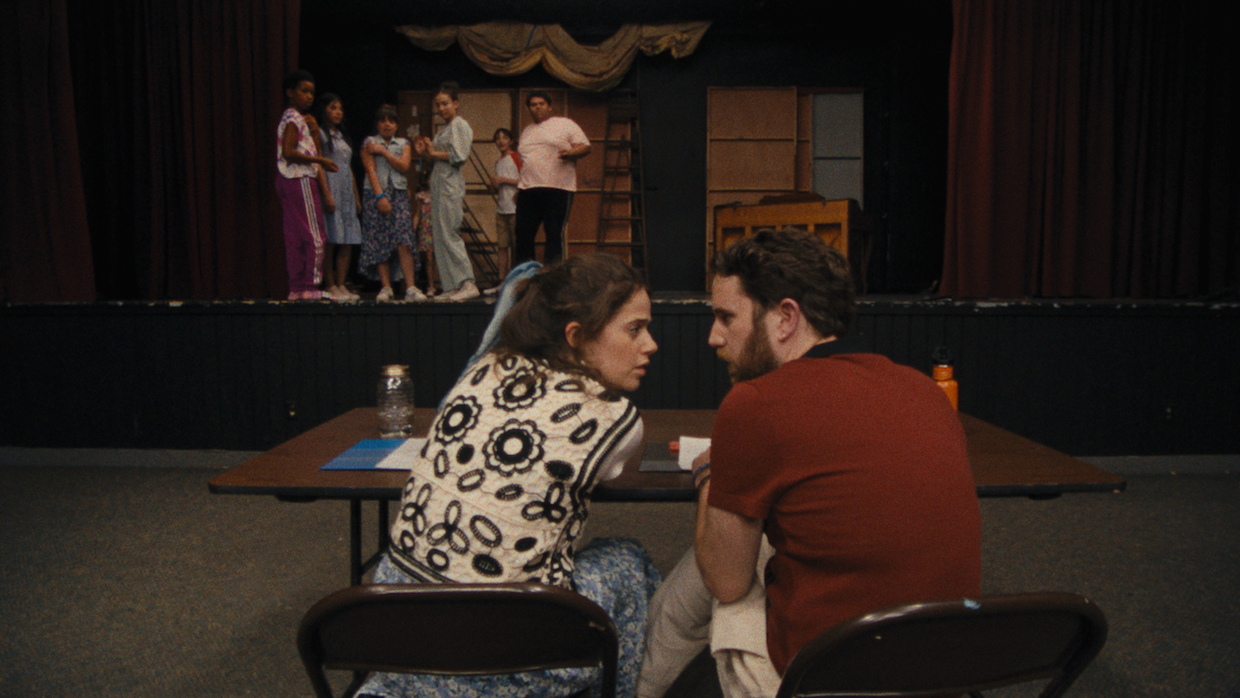 Back to selection
Back to selection
“I Could Tell There Was a Lot of Love in the Story and the Team Behind It”: DP Nate Hurtsellers on Theater Camp
 Theater Camp
Theater Camp The hilarious antics of campers and counselors alike is the basis of Theater Camp, the Cattskills-set mockumentary from co-directors Molly Gordon (who also stars) and Nick Lieberman. DP Nate Hurtsellers describes what initially drew him to working on the project, the films he looked to for visual inspiration and a particularly complicated aspect of the shoot.
See all responses to our annual Sundance cinematographer interviews here.
Filmmaker: How and why did you wind up being the cinematographer of your film? What were the factors and attributes that led to your being hired for this job?
Hurtsellers: I have a background in both documentary and fiction. I think that’s what initially drew the directors to me. I loved the script and loved the way [directors] Molly [Gordon] and Nick [Lieberman] wanted to approach this story. It’s laugh-out-loud funny and then suddenly heart-aching and then heart warming. I could tell there was a lot of love in the story and the team behind it, and that usually makes for my kind of movie.
Filmmaker: What were your artistic goals on this film, and how did you realize them? How did you want your cinematography to enhance the film’s storytelling and treatment of its characters?
Hurtsellers: We wanted to keep the film grounded. The camera work and lighting were designed to be naturalistic, imperfect, and un-pretty. The comedy and characters in the film are often wild, so we placed them in believable frames. I didn’t want anything to look too affected or “good”. We tried to incorporate the messiness that comes with real verité. We wanted it to feel truly documentary, and we held ourselves accountable for the realities that a documentary crew would be facing in telling this story. We frequently debated whether a camera could be placed somewhere without being “seen” by another operator. We broke that rule all over the place, but it definitely informed the spirit of our approach.
Filmmaker: Were there any specific influences on your cinematography, whether they be other films, or visual art, or photography, or something else?
Hurtsellers: We referenced a lot of iconic documentaries (Grey Gardens, Jesus Camp, High School, The War Room, etc). We also looked at the ensemble and distantly-observed quality of Altman’s Nashville. I’m sure I was also subconsciously pulling from the classically naturalistic craft I love, like Harris Savides or Robbie Ryan in his Andrea Arnold collaborations.
Filmmaker: What were the biggest challenges posed by production to those goals?
Hurtsellers: Everyone had to be “on” at all times. The camera might pan anywhere and focus on anyone at any moment, so Background, First Team, the sets — all of it needed to be prepped and camera ready. It was almost like a play, which made operating a lot of fun.
But this meant I leaned heavily on my camera team. We rarely laid marks, and things often changed from take to take. Added to that, we were frequently on the long end of the zoom (s16 64mm on A cam and 165mm on B cam). We also covered a lot of story ground each day, push-moving all across our summer camp location. I couldn’t have done it without a rockstar camera department.
Filmmaker: What camera did you shoot on? Why did you choose the camera that you did? What lenses did you use?
Hurtsellers: We shot on the ALEXA Mini in s16HD. Our lenses were Canon s16 zooms. The deeper focus and degradation from the smaller sensor and vintage lenses helped push the look toward a nostalgic, timeless aesthetic. And the lightweight but wide-range nature of s16 zooms allowed us to be appropriately nimble.
Filmmaker: Describe your approach to lighting.
Hurtsellers: Lighting needed to accommodate a lot of flexibility. Most of the film is cross-shot, meaning we were covering multiple actors and giving them lots of room to move and surprise us. We tried to light as naturally and 360° as possible. We used a lot of practicals or overhead soft sources. There was very rarely a light on a stand, so we could be free to look anywhere, anytime.
Filmmaker: What was the most difficult scene to realize and why? And how did you do it?
Hurtsellers: Everything presented its own unique challenges, but the theater set itself was particularly tough. We had to create nearly all of it from scratch, as there were no curtains or seats or power or lighting available within the space. That location didn’t come together till basically showtime. Then each number in the final show had to be programmed. Gaffer April Goldberg and Board Op. Jim Ed saved the day by going the extra mile with me to make sure everything was show ready.
Filmmaker: Finally, describe the finishing of the film. How much of your look was “baked in” versus realized in the DI?
Hurtsellers: We always intended a “film” look. The s16HD mode bakes in a lot (deeper depth of field, vintage lens characteristics, and a more forgiving sharpness, or lack thereof. Dailies colorist Dave Francis applied Filmbox halation and grain emulation to our dailies, which helped push the look much more toward classic s16mm. Once we got to the final grade with Nat Jencks, we modulated the grain and halation a little more from scene to scene.
TECH BOX
Film Title: Theater Camp
Camera: Alexa Mini
Lenses: Canon s16 8-64, 6.6-66, 11-165
Color Grading: Davinci Resolve with Nat Jencks at Postworks
